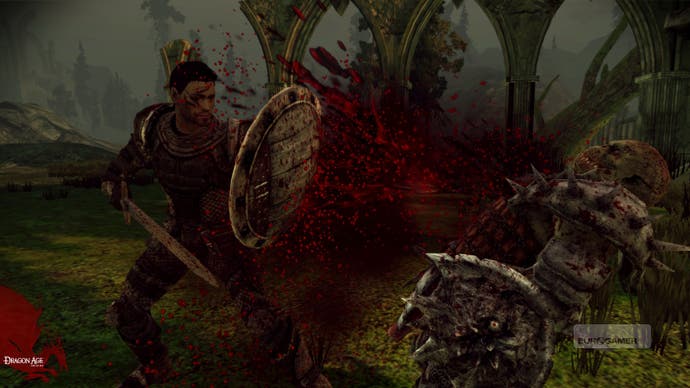Dragon Age: Origins
Age discrimination.
Your other principal choice at the start - your character's background - is a narrative one. This will dictate which of the six origin stories you play through before your character joins the elite Grey Wardens and begins the fight against Dragon Age's antagonists, the Darkspawn, in earnest. Each of these short stories (an hour or two in length apiece) puts BioWare's new fantasy universe in a different context. Several have political undertones; the downtrodden City Elves rebelling against their human overlords, for example, or the struggle of the Magi to exist under the tight control of the devout Templars. It's worth playing through some or all of these to get a feel for this entirely new, and surprisingly detailed, fantasy lore.
After your origin, you're ushered through a linear prologue (itself a good few hours long), which sees your character inducted into the Grey Wardens, introduces two key companions - the mysterious witch Morrigan, and faithful Warden Alistair - and which covers, via a brief dungeon, your role in a key battle against the Darkspawn. Treachery leads to defeat, the Wardens are decimated, and your character and Alistair set about picking up the pieces and rallying the fight against the Darkspawn in the troubled land of Ferelden. It's only at this point that the real Dragon Age: Origins begins, the game opening out into four major quests and a plethora of side-quests, all of which can be attempted in any order you like.
In gameplay if not dramatic terms, then, Dragon Age is a slow-burner. Throughout the origins and the prologue, combat happens in brief bursts, while storytelling happens in great spools of meandering, branching conversation as the world, the plot, the forces at work and the principal characters are mapped out in loquacious detail. It's not until you get stuck into your first major quest that you will spend as much time fighting as you spend talking, and by then you could be a dozen hours or more into the game. You will also have spent much of your time fighting accompanied by bit-part-players rather than the long-term party companions, interaction with whom - both on and off the battlefield - defines the game.

When it does eventually reveal itself in full, Dragon Age proves to be a flexible RPG that accommodates a wide range of playing styles. Baldur's Gate veterans will be happy pulling the camera back to a top-down view, pausing the action with the space bar and micro-managing the party's actions and placement in a quasi-turn-based mode. World of Warcraft players might prefer to zoom in close, let AI take care of party behaviour and punch out skills in real time, flicking between characters for variety. It's perfectly possible to smash through the game in this way on easy mode (the difficulty can be adjusted at any time) without ever hitting pause or needing to think, but even the normal setting is a significant step up that will require the occasional moment of reflection.
Or you could choose to do this reflection in advance - if that's not an oxymoron - by using Tactics. Tactics are a smart lift from, of all things, Final Fantasy XII. They are a version of that game's Gambits, a brilliant system of programmable rules for party behaviour that had the potential to revolutionise the single-player party RPG, but that we'd given up hope of ever seeing again after Square Enix dropped it. Happily, BioWare has had the good sense to revive it.








